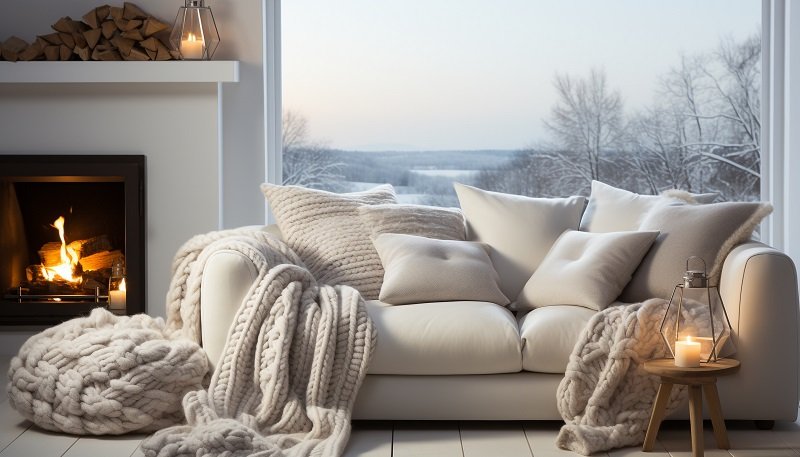Blog
What material are couches made of?

What materials are used to make sofas?
Introduction
For many of us, our sofa set is more than simply furniture; it’s an important part of our everyday life, a place where we make memories and find rest. But have you ever wondered what goes into producing your favorite piece of furniture?
Understanding the materials that make up your couch is essential, especially for those serious about home design. Each material has its unique set of properties, which influence not only the appearance and feel of your sofa but also its longevity and maintenance requirements. Whether you’re furnishing your first apartment, a busy mom seeking practicality, or someone who likes the finest things in life, understanding your sofa materials may help you make informed choices that align with your lifestyle and aesthetic preferences.
Overview of Common Couch Materials
As we begin our adventure into couch materials, let’s start with a general review of the most frequent varieties you’ll discover. Couches are made from various materials, each with unique properties that appeal to each person’s tastes and practical needs.
Types of Couches Fabric
When selecting a sofa, one of the first things to consider is the fabric. This fabric not only defines the couch’s appearance and feel but also its durability and simplicity of upkeep. Upholstery materials are classified into two types: natural fibers and human-made fibers.

Natural Fibers
1- Animal Fibers
- Silk: Imagine a sofa set that feels silky and smooth against your skin, like a luxury evening dress. Silk upholstery adds an air of beauty and refinement to any living area. It is best suited for low-traffic areas, though, because it is vulnerable to stains.
- Cashmere: Often associated with high-end knitwear, cashmere upholstery offers incomparable softness and warmth. Every time you sit down, it seems like you’re wrapped in a comfortable blanket. Ideal for warm, intimate situations, but not the best choice for houses with pets or children.
- Wool: Woolen couches are highly durable and naturally stain-resistant. They add a sense of rustic appeal and are ideal for creating a cozy, welcoming ambiance. Consider a wool couch to be your go-to winter coat—it’s durable, cozy, and always stylish.
- Leather: Leather is a symbol of classic sophistication and durability. It ages nicely, acquiring a deep patina over time, similar to your favorite leather jacket. Leather is perfect for busy families and people who value classic style since it is easy to clean and spill-resistant.
2- Plant Fibers
- Cotton: Cotton is a flexible and breathable fabric that feels similar to your favorite T-shirt—soft, comfy, and casual. It’s perfect for achieving a calm, lived-in appearance. However, it is sensitive to wrinkling and may require frequent maintenance to keep it looking good.
- Linen/Flax: Linen’s inherent shine and texture provide a sharp, clean look. It’s like your favorite summer outfit: cool, airy, and effortlessly elegant. Linen is ideally suited for formal living rooms or locations where you can admire its beauty without being concerned about heavy use.
- Hemp: Hemp is an environmentally friendly material that combines durability with a rustic appearance. It’s like a durable pair of jeans that you can rely on for years. Hemp upholstery is strong and resistant to wear and tear, making it ideal for high-traffic areas and eco-conscious homes.

Human-made Fibers
Human-made fibers, often known as synthetic fibers, are produced using chemical techniques. These fibers are preferred for modern upholstery because they provide increased durability, stain resistance, and affordability. Let us take a deeper look at some of these resources.
1- Natural Fibers
- Rayon: Rayon is a flexible fabric that has the texture of natural materials such as silk, wool, and cotton. It’s breathable and comfy, making it ideal for a wide range of upholstery applications. However, rayon is less durable than other synthetic materials, thus it may not be suitable for high-traffic locations.
2- Synthetic Fibers
- Polyester: Polyester is like a dependable, no-fuss friend you can always rely on. It’s long-lasting, stain- and fade-resistant, and reasonably easy to clean. This makes polyester a great choice for families with children or pets. Additionally, it can be combined with other fibers to improve its performance and look.
- Microfiber: A kind of polyester that feels like velvet but is more durable and stain-resistant. It’s the ideal balance of comfort and functionality, like a well-worn pair of sneakers you’ll never want to take off. Microfiber is an excellent choice for busy homes due to its ability to resist regular wear and tear.
- Olefin or Polypropylene: Olefin is known for its high resistance to stains, mildew, and fading, making it a good choice for outdoor furniture or spaces that get a lot of sunlight. Consider olefin as tough outdoor clothing that protects you from the weather. It is not as soft as some other alternatives, but it is quite durable.
- Nylon: Nylon is extremely strong and durable, with high abrasion resistance. It’s similar to durable hiking boots that can tackle difficult terrain. Nylon’s durability makes it ideal for high-traffic areas, yet it might feel stiffer than other materials.
- Acrylic: Acrylic is created to have the feel of wool, providing softness and warmth. It resists fading and stains, making it suitable for sunny areas. Imagine acrylic as a comfy sweater that keeps you warm and comfortable without getting worn out soon.

The Best and Worst Uses for Each Material
Understanding the strengths and weaknesses of each material can help you choose the right sofa set for your needs. Here’s a quick guide to the best and worst uses for the materials we’ve discussed:
- Silk
Best for: Low-traffic, formal living rooms or decorative pieces.
Worst for: Homes with young children or pets due to its delicacy. - Cashmere
Best for: Cozy, intimate settings where luxury is a priority.
Worst for: High-traffic areas or places prone to spills. - Wool
Best for: High-traffic areas needing durable, warm upholstery.
Worst for: Very humid environments, as it can retain moisture. - Leather
Best for: Busy households needing durable, easy-to-clean furniture.
Worst for: Extremely hot climates, as leather can become sticky. - Cotton
Best for: Casual, comfortable settings with a relaxed vibe.
Worst for: Areas prone to heavy stains and spills without protective treatments. - Linen
Best for: Formal living rooms or decorative purposes.
Worst for: High-traffic areas due to its tendency to wrinkle and stain. - Hemp
Best for: Eco-friendly, high-traffic areas needing sturdy upholstery.
Worst for: Homes seeking soft, luxurious textures. - Polyester
Best for: Families with children or pets, high-traffic areas.
Worst for: Those seeking natural, eco-friendly materials. - Microfiber
Best for: High-traffic areas needing durable, stain-resistant fabric.
Worst for: Those preferring the look and feel of natural fibers. - Olefin
Best for: Outdoor furniture or sunny rooms.
Worst for: Indoor settings where a softer feel is desired. - Nylon
Best for: High-traffic areas needing tough, resilient fabric.
Worst for: Homes preferring softer, more comfortable textures. - Acrylic
Best for: Sunny rooms needing fade-resistant fabric.
Worst for: Extremely high-traffic areas, as it can happen over time.
Conclusion
Choosing the proper sofa set material is a combination of personal choice, lifestyle requirements, and aesthetic preferences. From the luxurious feel of silk and cashmere to the practical durability of polyester and microfiber, each material has distinct advantages that can improve your living environment. By analyzing the advantages and disadvantages of each fabric, you can select a sofa that not only looks fantastic but will also meet your needs for years to come. Hope you all now can decide what material you should choose for your sofa set.
FAQs
1- What is the most durable couch material?
Leather and microfiber are generally considered the most durable couch materials. Leather is resistant to spills and wear, while microfiber is stain-resistant and holds up well in high-traffic areas.
2- Which couch material is easiest to clean?
Microfiber and leather are the easiest to clean. Microfiber is highly stain-resistant, and spills can often be wiped away with a damp cloth. Leather can be cleaned with a leather cleaner and conditioner.
3- What is the softest couch material?
Cashmere and silk are among the softest couch materials. They offer a luxurious, smooth feel but are best suited for low-traffic areas.
4- Are there eco-friendly couch materials?
Yes, materials like hemp, organic cotton, and recycled polyester are eco-friendly options. Hemp, in particular, is known for its durability and sustainability.
5- What couch material is best for households with pets?
Leather and microfiber are great choices for homes with pets. They are durable, resistant to stains, and less likely to trap pet hair compared to other fabrics.
6- Can I use outdoor fabric for indoor couches?
Yes, outdoor fabrics like olefin are increasingly being used indoors due to their durability and resistance to stains, mildew, and fading. They are especially good for sunny rooms and high-traffic areas.
7- What are some hypoallergenic couch materials?
Leather and synthetic fabrics like microfiber are hypoallergenic as they don’t harbor dust mites or pet dander as easily as natural fibers.
8- How do I maintain a linen couch?
To maintain a linen couch, vacuum regularly to remove dust and debris. Spot clean stains immediately with a mild detergent and water. Consider using a fabric protector to minimize stains and wrinkles.
9- Is velvet a good choice for a couch?
Velvet is a luxurious choice that offers a rich, soft texture. However, it is best suited for low-traffic areas as it can be prone to crushing and staining.
10- What should I consider when choosing a couch material?
Consider factors like durability, ease of cleaning, comfort, aesthetic preferences, and who will be using the couch. For example, families with young children or pets might prioritize durability and stain resistance, while someone looking for luxury might prefer the softness of silk or cashmere.


